When it comes to winemaking and wine tasting in the United States, Napa Valley is the first thing that comes to mind.
But many visitors to Napa Valley aren’t aware that there’s a thriving sparkling wine culture in Napa.
It all starts in the prime vineyards of our region, which are ideal for quality sparkling wine:
Napa Sparkling Wine Vineyards

Climate & Geography of Napa
Due to its dramatic geography and close proximity to the Pacific Ocean, Napa Valley is a region of microclimates .
Some vineyards are perfect for warmer weather varietals like Cabernet, while other sites are ideal for growing cooler climate varietals – like the Pinot Noir, Chardonnay, and Petit Meunier, that generally go into sparkling wine.
Perfect Ripeness
Great sparkling wine requires grapes that are perfectly ripe . If grapes are exposed to too much heat, sugar rises, making the wine overblown and sweet.
Here at V. Sattui, we use our cooler, coastal-climate vineyards – which also get ample sun – to produce our sparkling wine, as they create berries of balanced ripeness and acidity , such as in our V. Sattui Prestige Cuvée Brut.
Diverse Vineyard Sites
Using fruit from multiple vineyard locations gives Napa winemakers the chance to benefit from different terroirs .
For example, for some of our sparkling wine, we source fruit from our estate property in Anderson Valley (a neighboring region situated a bit closer to the ocean).
This lends the influence of a transverse mountain range topography (East to West) along with varying soil types, and a collage of microclimates that keep the vineyards cool – and make the resulting wines distinct.
Napa Valley Sparkling Wine Tastings
Tasting sparkling wine at the winery source is a great pleasure. There are many places to taste excellent bubbles in Napa Valley – and these are some of our favorites among our neighbors in the valley:
Chandon

Chandon is part of the Moet & Chandon family of wineries and their Yountville tasting room provides an in-town location plus a terrace with vineyard views.
They have two standard tastings – their Chandon Signatures (the classics) and Chandon Mavericks (which features a more unexpected assortment of wines).
Mumm

Mumm is one of Napa’s biggest sparkling producers, so you’ve likely seen their bottles at your local grocery store.
They offer various tasting options from their Rutherford hospitality space, from flights of sparkling on their patio to indoor tastings, both of which feature views of the surrounding vineyards and Mayacamas Mountains.
Domaine Carneros
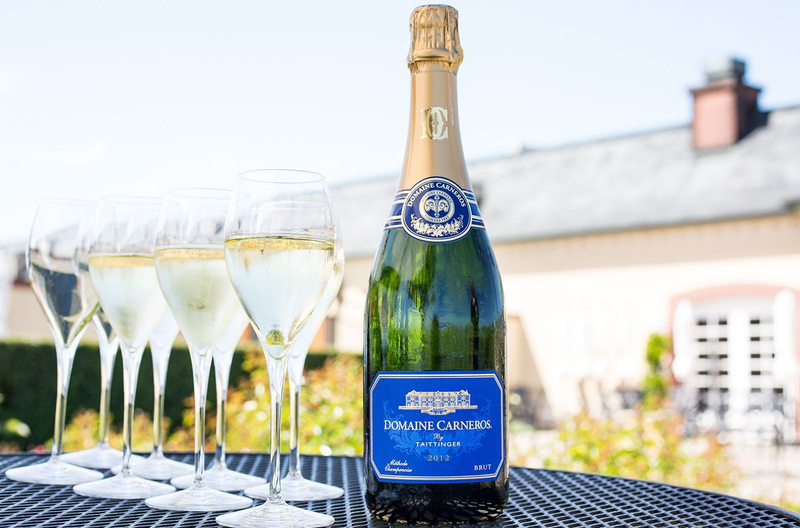
Domaine Carneros is a well-known sparkling winery located at a highly traversed rural location in the Carneros region of Napa Valley. Their imposing French chateau style facility offers a unique experience inspired by the Champagne region of France, with formal gardens and expansive outdoor terraces.
They offer several tasting flights, cheese & charcuterie selections, caviar pairings, and more.
You can’t go wrong with any of these recommendations, and there are many more to explore (including Schramsberg in St. Helena, Iron Horse or J in Sonoma County, Roederer in Anderson Valley, plus many more). But these are a great place to get started!
Champagne vs. Sparkling Wine
For many new Napa Valley visitors, there are different terms, traditions, and experiences to enjoy in the world of sparkling wine – but it can be a little intimidating!
The first question you often wonder is: what’s the difference between champagne and sparkling wine?
What is Champagne?
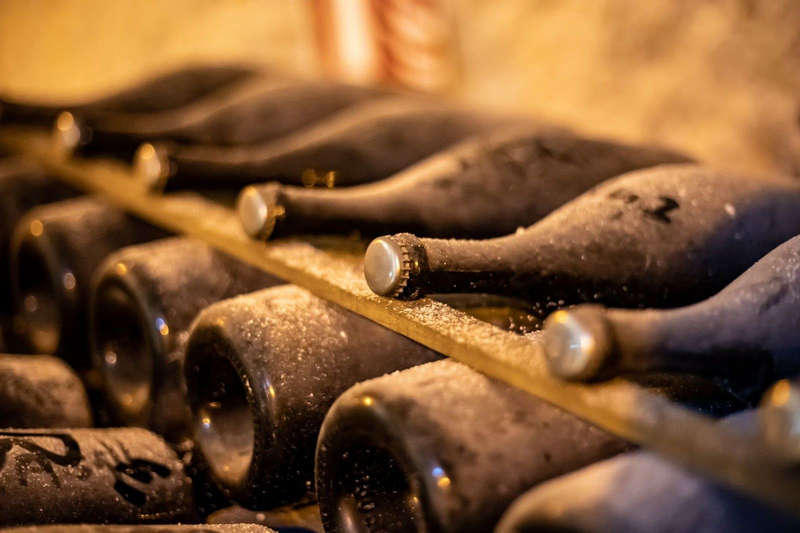
By law, sparkling wine can only be referred to as “Champagne” if it comes from the Champagne winemaking region in France, and only from Chardonnay, Pinot Noir, and Pinot Meunier.
It all started in France in the 1700s, in the district of Champagne, when a blind monk named Dom Perignon used corks instead of rags to stop bottles. Warm spring weather caused a second fermentation, with the corks trapping the natural CO2 – creating bubbles.
When he tasted the wine, he exclaimed, “Come quickly my brothers, I am drinking stars!” This famous quote is used widely to this day.
Champagne must also be made by the traditional, regulated method, the “Methode Champenoise .” This consists of:
- A primary fermentation in a tank, creating a base wine or wines
- Blending different wines into a master blend
- Secondary fermentation in the bottle to create those wonderful bubbles
- Riddling to collect the spent yeast and soften and add complexity to the wine
- Disgorging , where the spent yeast is removed
- Dosage , adding a touch of sugar for the desired sweetness style
- Capping and aging to soften and further develop the wine’s profile.
This process creates a few different flavor profiles that can be present in various sparkling wines and champagne, from apple and pear sharpness and lift to luxurious brioche, yeasty notes.
Sweetness Levels of Champagne and Sparkling Wine Explained
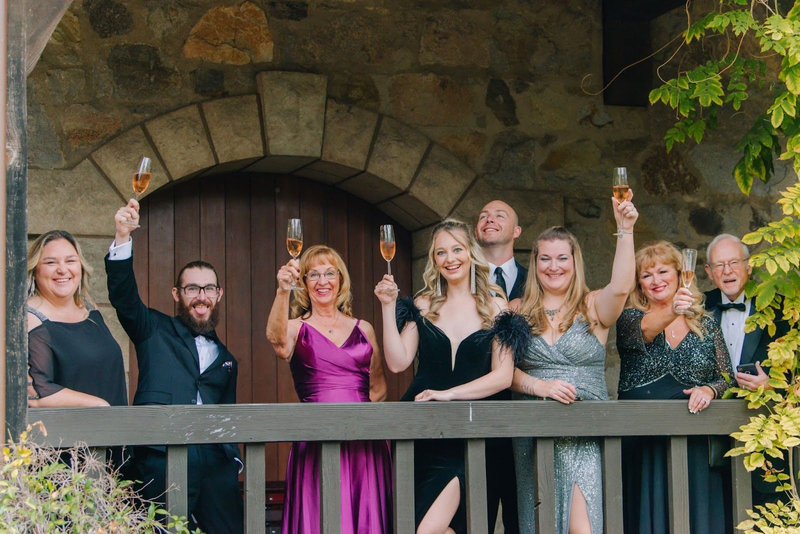
There are also those classic words that can confuse most tasters, relating to the residual sugar in the wine: Extra Brut, Brut, Extra Dry, Sec, Demi-Sec, and Doux .
Interestingly, the sweetness scale isn’t always intuitive: “Extra Dry” Champagne is actually sweeter than “Brut,” for example.
Here they are broken down:
Extra Brut | Bone Dry
The driest sparkling, (0.6% sugar or less) with zesty citrus and refreshing minerality. Pair with oysters, crudo, or enjoy solo.
Brut | Balanced & Classic
The classic, (1.5% sugar) fruity and bubbly with hints of toast and brioche, balanced fruitiness and acidity. Think apples, pears, brioche, and vibrant bubbles. Ideal for appetizers, cheeses, or throughout meals.
Extra Dry | Subtle Sweetness
A touch sweeter than Brut (1.2% to 2%) with ripe peach, honey, and toasty notes. Perfect for seafood pasta, creamy cheeses, or fruit desserts.
Sec | Indulgent
Playfully sweet (1.7% to 3.5%) with apricot, melon, and honey. Pairs beautifully with roasted poultry, glazed ham, or spicy Asian cuisine.
Demi-Sec | Dessert Worthy
The sweetest, (3.3% to 5%) with ripe berries, candied citrus, and caramel. A great pairing with desserts like chocolate mousse, crème brûlée, or fruit tarts.
Sparkling Wines in Napa
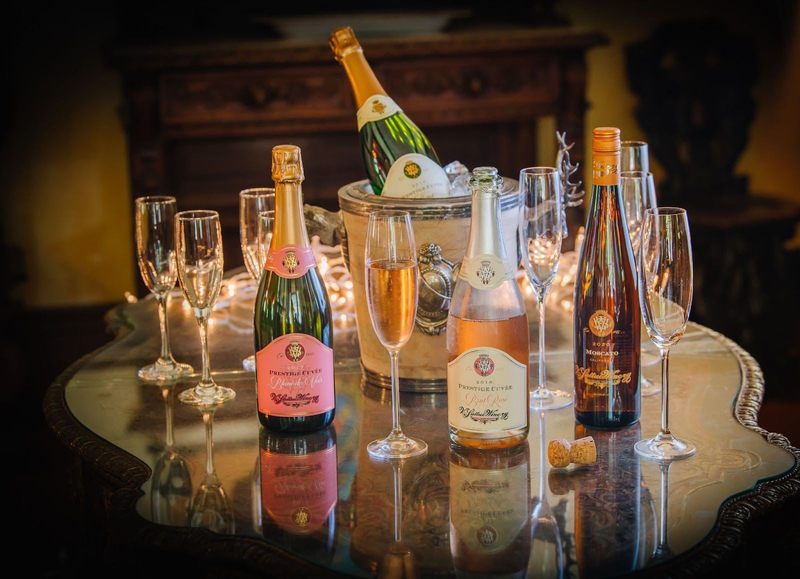
Many other sparkling wineries, including Napa’s, follow the same Methode Traditionelle, in practice, just under a different name (“Traditional Method “) to make gorgeous world-class bubbles.
However, while most French winemakers stick to the belief that champagne should be crafted out of just the three grape varietals — Pinot Noir, Chardonnay and Pinot Meunier – Californian vintners also test the limits of tradition, and many wineries (ourselves included) are making great sparkling wine from other varietals too.
Napa sparkling wine specifically is crisp, refreshing, and a beautiful food pairing that makes it incredibly enjoyable.
Its lightness of body and effervescence invigorates the palate, and, as we like to think, the whole self – and it’s been growing in popularity in recent years.
These sparkling styles are common from Napa Vintners and popular among wine enthusiasts too:
List of Common Sparkling Wines Made In Napa (and at V. Sattui!)
Prestige Cuvée Brut
The 2021 vintage exudes a welcoming brightness, featuring aromas of mandarin orange and subtle undertones of lime zest.
Each taste is a delightful explosion of nectarine and pear flavors, complemented by a traditional toasty undertone and hints of almond on the finish.
Prestige Cuvée Brut Rosé
This dry elegant sparkling wine is bright and inviting with its blushing peach color, and fresh strawberry bouquet.
Crisp, delicate, and refreshing with an effervescent complexity of orange blossom, that melds into a soft green apple finish. Believe us when we say this wine is dangerously delicious!
Blanc de Noir
The 2017 “Blanc de Noir” is a wonderful harmonization between the soft and delicate nuances of a sparkling wine and the complexities of the Pinot Noir grape. A lovely wine with not only a beautiful color but bright with inviting notes of fresh strawberry and cranberry aromas.
Each sip is delightfully balanced with a refreshing acidity and a hint of natural sweetness accompanied by its subtle creamy texture and effervescence.
Moscato
Our Moscato Frizzante is similar to a sparkling wine with just a touch of sweetness. Its light and effervescent little bubbles are bursting with aromas of orange blossom, lychee, and jasmine.
On the palate this wine presents tropical fruit notes with hints of orange zest that create a lasting impression- a perfect wine for any celebratory occasion!
Napa Sparkling Wine: Frequently Asked Questions
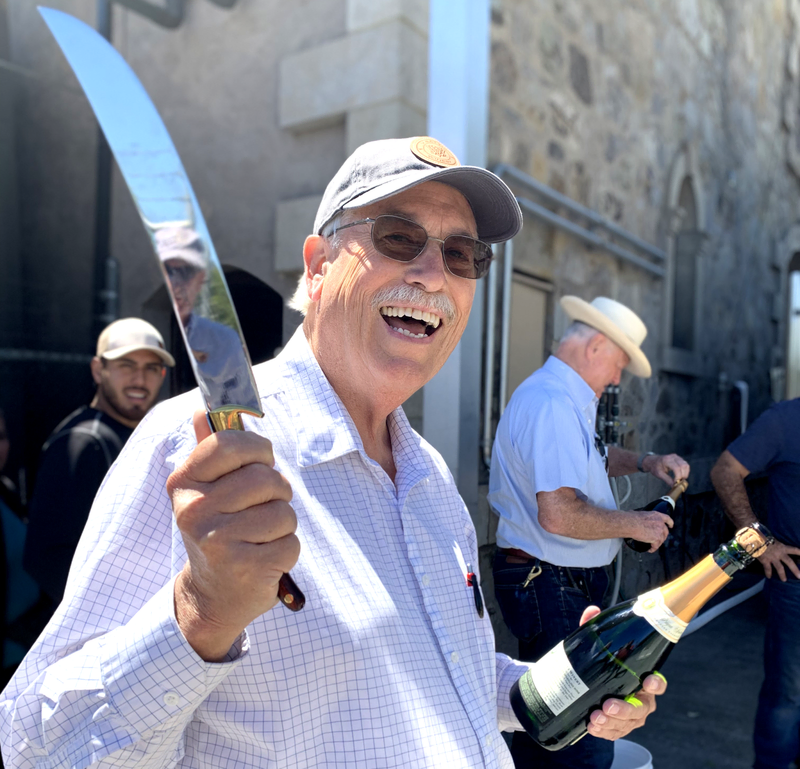
What is sparkling wine?
Effervescent wine made from a traditional method of double fermentation, riddling, aging, and disgorging, and adding a touch of sweetness.
How long does sparkling wine last?
Sparkling Wine has a wide range for aging depending on quality. Recommended aging for most Napa Valley sparkling wines is 3-10 years.
How to open sparkling wine?
You can use the classic champagne sabre if you’re feeling celebratory, sliding it quickly and smoothly up the neck to pop the cork off.
Otherwise, remove the foil cap, and place your thumb on top of the cork. Remove the muselet, the wire cage, keeping constant pressure on the cork. Grasp the bottle’s body in one hand and the cork in the other, and gently and slowly twist the bottle while holding the cork until you hear a slight sigh – and enjoy! This preserves the carbonation of the beverage.
How to store sparkling wine?
Store sparkling wine similarly to the way you cellar your other wines. Ideally in a temperature controlled environment (50 to 55 degrees), with minimal light exposure. Store horizontally if cellaring 3 or more years.
How much does a bottle of sparkling wine cost?
Sparkling wine prices vary greatly depending on whether the brand mass produces for distribution (usually non-vintage) or produces small batch vintaged wines. Range can be $16 to $140 per bottle.
V. Sattui’s Napa Bubble Bar
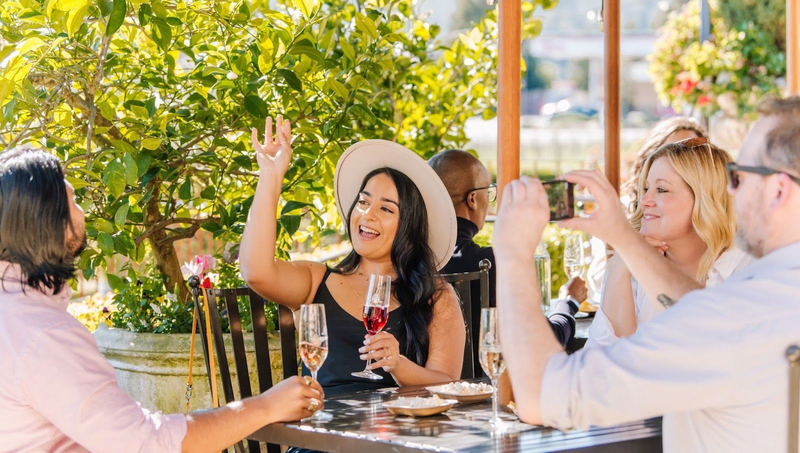
Sparkling wine feels like a celebration. It’s associated with parties, exciting news, gathering with people you care about, abundance and joy.
The sound of the cork popping and the visual sight of bubbles floating upwards all contribute to a general feeling of happiness and anticipation.
In fact, at V. Sattui we always greet and serve guests a glass of sparkling wine upon arrival to our annual Harvest Ball event, where it’s paired with passed appetizers.
One of the oldest Napa Valley wineries, we’ve been making sparkling wine since the 1990s . We’re also one of the first wineries in the valley to offer hospitality and tasting experiences , and one of the only Napa Valley wineries that has a specialized tasting area just for bubbles – our iconic Bubble Bar , where visitors enjoy:
- Panoramic views of our estate and nearby Vittorio’s Vineyard
- A sampling of four sparkling wines paired with salty snacks or several other available treats (chocolate truffle pairings, savory bites, and more)
- Sparkling wine tasting in any of our other tasting areas, including the Marketplace , Terrace , and Reserve Tower
Napa Valley sparkling wine is very special, from the way it’s made to the way it makes people feel. There’s a long history to explore, and a lot of fun to be had.
We hope this guide gives you an overview of the basics to get started with your own sparkling wine experience – there’s so much to enjoy, especially at our estate winery here in St. Helena.
Click here for reservations, including to our effervescent Bubble Bar – and cheers!